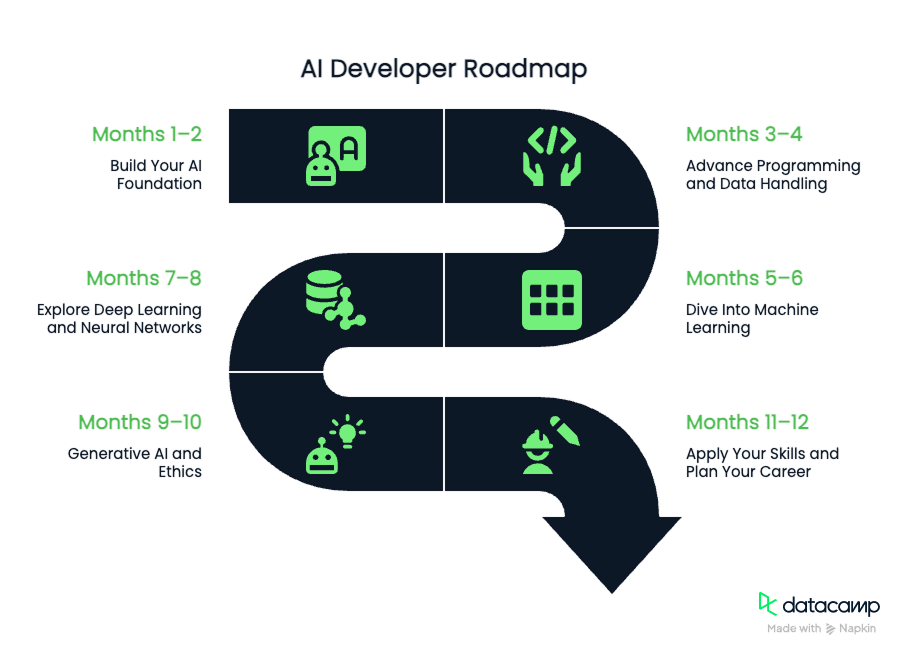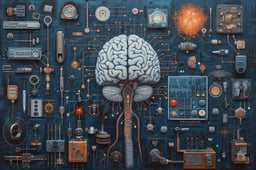Track
AI is changing the way we work and live, a vital engine driving innovation in industries like healthcare, finance, retail, and logistics. As organizations invest in new technologies, the demand for skilled AI developers is higher than ever, opening up exciting opportunities for those eager to build intelligent solutions. Indeed, according to McKinsey's 2024 State of AI report, hiring skilled AI professionals has become increasingly challenging, with around 75% of organizations reporting difficulty recruiting AI data scientists, and approximately 65% struggling to hire machine learning engineers. The State of Data and AI Literacy Report 2025 found similar trends, with 69% of leaders saying that AI literacy is essential for day-to-day work.
But with so much information and so many tools available, knowing where to start and how to progress confidently can be daunting. Becoming proficient in AI isn’t about trying to learn everything at once. Instead, it’s a journey of steady growth, combining foundational theory, practical experience, and continuous exploration.
This AI developer roadmap breaks down the path to AI mastery into clear, manageable stages. Whether you’re just graduating, transitioning from software engineering, or self-taught and ready for the next level, you’ll find a step-by-step guide to developing essential skills, hands-on experience, and the industry insight needed to thrive as an AI professional in the years ahead.
We keep our readers updated on the latest in AI by sending out The Median, our free Friday newsletter that breaks down the week’s key stories. Subscribe and stay sharp in just a few minutes a week:
If you’re looking for a more general guide on AI learning, check out our post on How to Learn AI in 2025.
TL;DR: 12-Month AI Developer Learning Path
For those looking to get a snapshot of the AI developer roadmap, here are the milestones you’ll want to hit as you progress:
- Months 1–2: Build a foundation in math, statistics, and Python.
- Months 3–4: Level up your programming and data handling skills.
- Months 5–6: Dive deep into core machine learning algorithms.
- Months 7–8: Explore deep learning and neural networks.
- Months 9–10: Understand generative AI, large language models, and ethical AI.
- Months 11–12: Apply your knowledge through projects and explore career options.
- Always: Engage with the AI community and keep learning.

Months 1–2: Build Your AI Foundation
Every strong AI career starts with the basics. Begin by developing your mathematical thinking, statistical understanding, and core programming skills—these are the pillars that support all future progress.
Focus on mathematics and statistics
A working knowledge of math is essential for making sense of how AI models work. In these first months, dedicate time to:
- Linear algebra: Grasp vectors, matrices, and operations like multiplication and eigenvalues. These concepts are fundamental for how data and models are structured.
- Calculus: Understand derivatives, partial derivatives, and the chain rule. This makes optimization techniques like gradient descent far more intuitive.
- Probability and statistics: Get comfortable with basic probability, Bayesian thinking, and hypothesis testing. These skills help you interpret data and model performance reliably.
Get comfortable with Python programming
Python is the go-to language for AI development. Start by:
- Learning Python basics: Variables, control flow, data types, and functions. Python’s clear syntax makes it easy to pick up and experiment with.
- Practicing data manipulation: Explore libraries like NumPy for numerical work and Pandas for organizing and analyzing datasets.
- Visualizing data: Use Matplotlib or Seaborn to create plots that help you discover trends and communicate insights.
Top resources for months 1-2
These resources can help you get started on your journey and master some of the fundamental skills you’ll need:
- AI Fundamentals Skill Track: Build your foundational knowledge of the concepts behind AI.
- Python Programming Fundamentals Skill Track: Build your Python programming skills with hands-on exercises.
- Statistics Fundamentals in Python Skill Tack: Get familiar with the core concepts of statistics.
- Probability and Statistics courses: Explore our range of courses to master different principles.
As you progress, consider tackling beginner-friendly Python projects and exercises to solidify your understanding. For step-by-step guidance, our Associate Python Developer track offers practical, hands-on learning to get you started.
Months 3–4: Advance Programming and Data Handling
With the basics in place, it’s time to deepen your programming skills and master real-world data wrangling, as this is the fuel for powerful AI models.
Strengthen your programming toolkit
- Object-oriented programming (OOP): Learn to organize code using classes and objects. OOP makes it easier to manage and reuse code, especially in larger AI projects.
- Version control with Git: Familiarize yourself with tools for tracking changes, collaborating, and managing your codebase. These are essential for teamwork and open-source work.
Become a data wrangling expert
High-quality data is the backbone of every successful AI system. Focus on:
- Data cleaning: Practice techniques for handling missing data, identifying outliers, and fixing inconsistencies.
- Feature engineering: Transform raw data into valuable features using scaling, normalization, and encoding methods. Well-crafted features improve model performance significantly.
- Automation with Scikit-learn: Use preprocessing modules to streamline repetitive data tasks and build reliable data pipelines.
Top resources for months 3-4
As you build these skills, you’ll be ready to tackle larger and more complex data challenges. These resources can help:
- Building Applications with OOP in Python skill track: Master the fundamentals of object-oriented programming, including inheritance, polymorphism, type hinting, abstract base classes, and interfaces
- GitHub Foundations skill track: Learn the fundamentals of Git and GitHub, including version control, collaboration, and branching.
- Data Cleaning in Python course: Explore how to clean common and advanced data problems along with record linkage.
- Feature Engineering for Machine Learning in Python course: Learn to prepare data for machine learning models by exploring how to preprocess and engineer features from categorical, continuous, and unstructured data.
- Machine Learning with scikit-learn course: Grow your machine learning skills with scikit-learn in Python. Use real-world datasets in this interactive course and learn how to make powerful predictions.
If you're looking to practice with guided projects, the Associate AI Engineer for Developers track integrates real-world scenarios, while the Associate Data Engineer in SQL track can help you handle larger datasets more efficiently.
Months 5–6: Dive Into Machine Learning
Equipped with a solid foundation in programming and data handling, you’re ready to explore the heart of applied AI: machine learning. This is where your skills come together to solve real problems.
Master core algorithms
- Supervised learning: Start with linear regression for prediction and support vector machines for classification. These are foundational algorithms for most business AI projects.
- Unsupervised learning: Try k-means clustering for pattern discovery and principal component analysis (PCA) for reducing data complexity.
- Ensemble methods: Learn how models like random forests and gradient-boosted trees (such as XGBoost) combine the strengths of multiple algorithms for better accuracy, especially with messy or imbalanced datasets.
Evaluate and optimize your models
Understanding how to judge and improve your models is as important as building them:
- Select the right metrics: Accuracy, precision, recall, F1-score, and R² each tell a different story about your model’s performance.
- Tune hyperparameters: Use tools like GridSearchCV to systematically find the settings that produce the best results.
- Guard against overfitting: Apply cross-validation (like k-fold validation) to test your model’s ability to generalize.
Top resources for months 5-6
If you want hands-on experience, we have several options to help with this phase of the AI developer roadmap:
- Machine Learning Scientist in Python career track: Combine learning in data science and machine learning to help you develop the skills for success.
- Supervised Machine Learning in Python skill track: Master the fundamentals of supervised machine learning and discover how to make predictions using labeled data.
- Unsupervised Learning in Python course: earn the fundamentals of unsupervised learning and implement the essential algorithms using scikit-learn and SciPy.
- Ensemble Methods in Python course: Learn how to build advanced and effective machine learning models in Python using ensemble techniques such as bagging, boosting and stacking.
Additionally, the Developing AI Applications track provides practical projects, while the Associate AI Engineer for Data Scientists track dives deeper into evaluation and optimization strategies. For a broader perspective, the MLOps Roadmap shows how these skills fit into production workflows.
Months 7–8: Explore Deep Learning and Neural Networks
AI is advancing rapidly thanks to deep learning. Over these two months, you’ll get hands-on with the architectures and tools that power today’s most impressive AI systems.
Learn about deep learning architectures
- Convolutional neural networks (CNNs): Essential for working with images, CNNs power everything from facial recognition to medical diagnostics.
- Recurrent neural networks (RNNs): Discover how RNNs and variants like LSTMs handle sequential data, like language or time series.
- Transformers: Dive into the architecture behind breakthroughs in natural language processing (NLP), such as GPT-4, which set the standard for modern AI text applications.
Build with industry-standard frameworks
- PyTorch and TensorFlow: Get comfortable with both, as each has its strengths. PyTorch is popular for research and experimentation, while TensorFlow is widely used for production deployment.
- Hugging Face Transformers: Experiment with cutting-edge pre-trained models to accelerate development and tackle advanced NLP problems.
Top resources for months 7-8
At this point, you’ll want to explore some of the key principles behind AI models. These resources can help:
- Introduction to CNNs Tutorial: A guide to understanding CNNs, their impact on image analysis, and some key strategies to combat overfitting for robust CNN vs deep learning.
- Recurrent Neural Networks for Language Modeling course: Learn how to use RNNs to classify text (binary and multiclass), generate phrases, and translate Portuguese sentences into English.
- Transformer Models with PyTorch course: Discover the different components that make up the transformer architecture: positional encoding, attention mechanisms, and feed-forward sublayers.
As you work on projects, Developing AI Systems with the OpenAI API to see how generative models are used in real-world contexts. For a quick overview of the ecosystem, check out The Generative AI Tools Landscape.
Months 9–10: Generative AI and Ethics
As your technical skills deepen, it’s important to understand both the latest trends in generative AI and the ethical responsibilities that come with building impactful systems.
Explore generative AI and large language models
- Transfer learning: Learn how to adapt powerful models to new tasks with minimal data by fine-tuning on specialized datasets.
- Retrieval-augmented generation (RAG): Investigate methods for combining large language models with external knowledge sources, making AI outputs more accurate and context-aware.
Embrace ethical AI practices
- Bias and fairness: Develop techniques for identifying and reducing bias, ensuring your models treat users fairly and inclusively.
- Explainability: Use interpretability tools—such as SHAP values—to help users and stakeholders understand how your models make decisions.
- Regulatory understanding: Stay informed about emerging regulations, including frameworks like the EU AI Act, so your work remains responsible and compliant.
Top resources for months 9-10
There are several new DataCamp resources that can help you get up-to-date with the latest in generative AI:
- Transfer Learning Guide: Learn about transfer learning, fine-tuning, and their foundational roles in machine learning and generative AI.
- Retrieval-Augmented Generation (RAG) with LangChain: Learn how to integrate external data into large language models (LLMs) to extend their knowledge and make them more use-case-specific.
- Agentic RAG: Step-by-Step Tutorial with Demo Project: Learn how to build an Agentic RAG pipeline from scratch, integrating local data sources and web scraping to generate context-aware responses to user queries.
- AI Ethics Course: This introductory course on AI ethics provides a comprehensive overview of ethical considerations in the fast-paced domain of artificial intelligence.
- Explainable AI, LIME and SHAP for Model Interpretability tutorial: Dive into Explainable AI (XAI) and learn how to build trust in AI systems with LIME and SHAP for model interpretability. Understand the importance of transparency and fairness in AI-driven decisions.
If you want to practice building with these concepts, Developing LLM Applications with LangChain offers hands-on experience with retrieval-augmented systems. To keep up with emerging trends and best practices, DataCamp Radar provides updates on both the technical and regulatory landscape.
Months 11–12: Apply Your Skills and Plan Your Career
The final stage of your journey is about putting everything together—building real-world projects, developing a standout portfolio, and charting your career trajectory.
Build real-world projects that showcase your skills
- Start simple: Tackle image classification using CNNs with datasets like CIFAR-10 or MNIST to consolidate your deep learning knowledge.
- Go advanced: Try your hand at building recommender systems, developing chatbots, or working with time-series forecasting.
- Share your work: Use platforms like your DataCamp portfolio and GitHub to document and display your code. These public projects help you practice collaboration and make your skills visible to potential employers.
Explore career pathways and specializations
- Map your progression: Understand the difference between roles like ML Engineer, AI Developer, and AI Architect. Each has unique responsibilities, from hands-on coding to strategy and leadership.
- Find your niche: Industries like healthcare, finance, and retail offer distinct challenges and opportunities for AI. Consider projects in areas that excite you or address problems you care about.
Top resources for months 11-12
- 7 Exciting AI Projects for All Levels: Develop your portfolio and improve your skills in creating innovative solutions for complex problems by working on AI projects.
- Building Chatbots with the OpenAI API and Pinecone tutorial: Use your skills with OpenAI, Pinecone, and LangChain to create a chatbot that answers questions about research papers.
To deepen your expertise and find capstone project ideas, the Associate AI Engineer for Developers and Developing AI Applications tracks provide hands-on options. Connecting with the community through events like Radar AI is a great way to learn about emerging specializations and expand your network.
Conclusion
Charting your path to AI mastery is both a challenge and an adventure. By taking this step-by-step approach grounded in strong fundamentals, hands-on practice, and real-world projects, you’ll set yourself up to thrive in this fast-moving field.
Remember: learning AI is a lifelong journey. The best AI practitioners are those who stay curious, keep building, and connect with the community. No matter where you are now, with consistent learning and engagement, you’ll be ready to shape the future of AI.
Get started today with the AI Fundamentals track.
AI Developer Roadmap FAQs
What are the must-have skills for an AI developer in 2025?
A successful AI developer brings together strong Python programming, a solid command of machine learning and deep learning frameworks, and experience with data manipulation and preprocessing. Understanding ethical AI principles and being able to communicate results clearly are just as important.
How do I keep up with the fast pace of AI?
Stay curious and proactive. Follow respected AI publications, subscribe to industry newsletters, and participate in conferences or webinars. Engaging with online communities and exploring new tools will keep your skills current and your thinking fresh.
Where should I start if I’m new to AI?
Begin with structured, hands-on tracks like Python Developer or Associate AI Engineer for Developers. Complement your learning with real-world projects and by reading industry blogs.
How long does it usually take to get proficient in AI?
The timeline varies, but with consistent effort, most learners become comfortable with core concepts and tools in 6 to 24 months. The key is steady, focused practice and continuous learning.
How do AI engineering and data science differ?
AI engineering focuses on building, deploying, and optimizing AI systems—often emphasizing software skills and scalable solutions. Data science is more about analyzing data, building models, and generating insights. Both paths share many foundational skills and often overlap.

A senior editor in the AI and edtech space. Committed to exploring data and AI trends.



